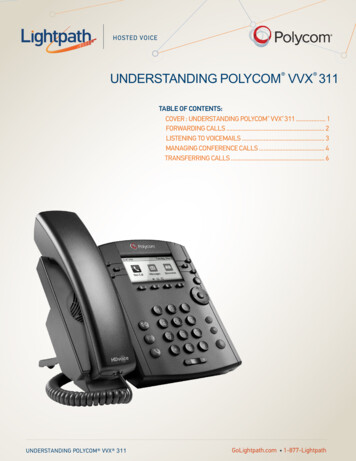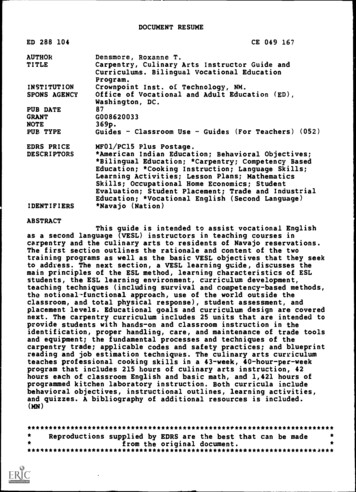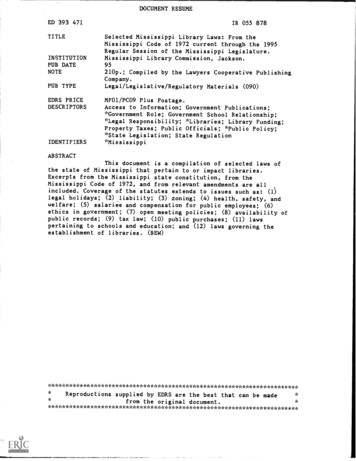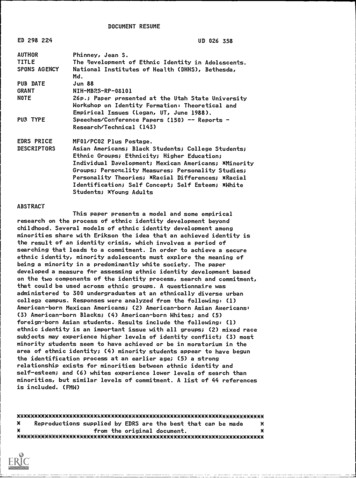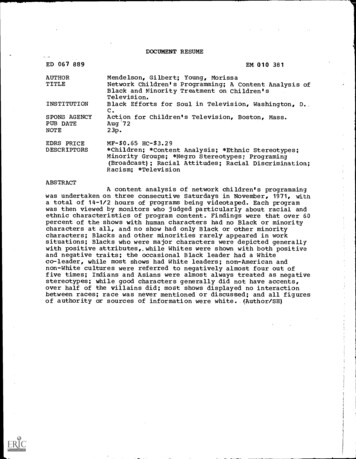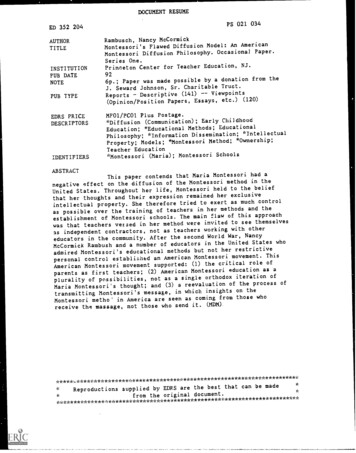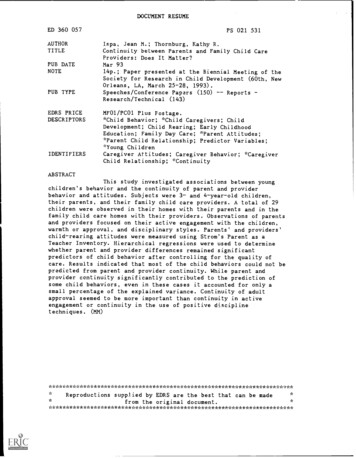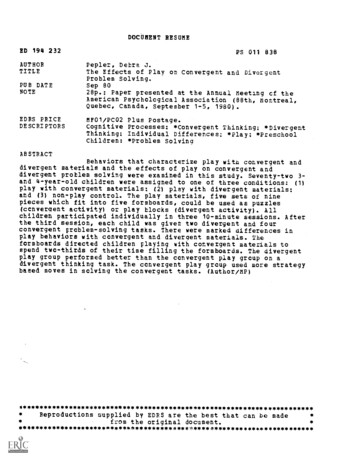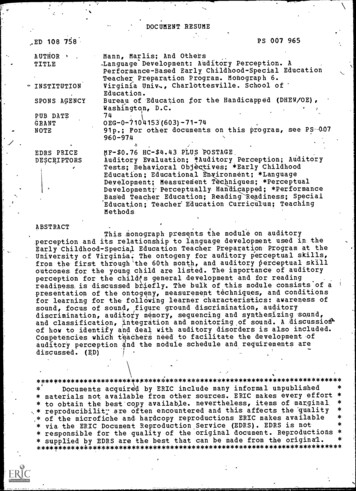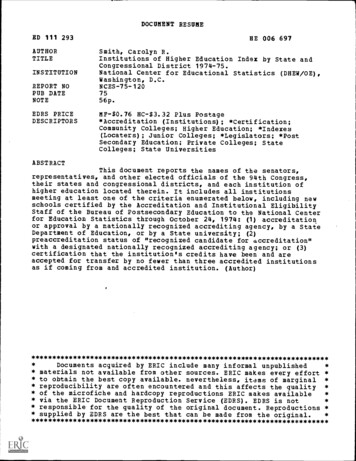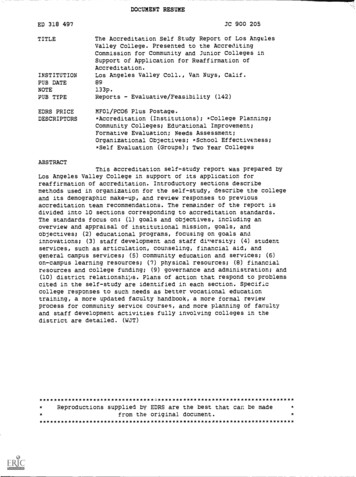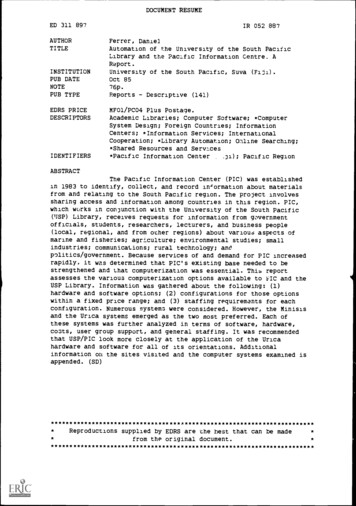
Transcription
DOCUMENT RESUMEED 311 897AUTHORTITLEINSTITUTIONPUB DATENOTEPUB TYPEEDRS PRICEDESCRIPTORSIDENTIFIERSIR 052 887Ferrer, DanielAutomation of the University of the South PacificLibrary and the Pacific Information Centre. AReport.University of the South Pacific, Suva (Fiji).Oct 8576p.Reports - Descriptive (141)MF01/PC04 Plus Postage.Academic Libraries; Computer Software; *ComputerSystem Design; Foreign Countries; InformationCenters; *Information Services; InternationalCooperation; *Library Automation; Online Searching;*Shared Resources and Services*Pacific Information Center.ji); Pacific RegionABSTRACTThe Pacific Information Center (PIC) was establishedin 1983 to identify, collect, and record ifformation about materialsfrom and relating to the South Pacific region. The project involvessharing access and information among countries in this region. PIC,which works in conjunction with the University of the South Pacific(USP) Library, receives requests for information from governmentofficials, students, researchers, lecturers, and business people(local, regional, and from other regions) about various aspects ofmarine and fisheries; agriculture; environmental studies; smallindustries; communications; rural technology; andpolitics/government. Because services of and demand for PIC increasedrapidly, it was determined that PIC's existing base needed to bestrengthened and that computerization was essential. This reportassesses the various computerization options available to FIC and theUSP Library. Information was gathered about the following: (1)hardware and software options; (2) configurations for those optionswithin a fixed price range; and (3) staffing requirements for eachconfiguration. Numerous systems were considered. However, the Minisisand the Urica systems emerged as the two most preferred. Each ofthese systems was further analyzed in terms of software, hardware,coats, user group support, and general staffing. It was recommendedthat USP/PIC look more closely at the application of the Uricahardware and software for all of its orientations. Additionalinformation on the sites visited and the computer systems examined isappended. **************************Reproductions supplied by EDRS are the best that can be madefrom the original ********************************
U S DEPARTMENT OF EDUCATIONOffice of Erie atonal Research and improvemetEDUCATIONk RESOURCES INFORMATIONCENTER 1E4 This document has been ieoiodui-ed asreceived Iron Ore person 0, Or gar,tation.cht,ornating itk")'Minor Changes have jeer made Iii improvereproduction qualityAPoints , weep r op n01, stated in V' SdOikrent 00 not necessarily represent officialOE RI position Or PidliCYUniversity of the South1.4Wi i centreA ReportsibyDardel FerrerThe University Of the south PacificLibraryOctober 198' PERMISSION TO REPRZ DUCE 1HIS1,zLL.MATERIAL HAS BEEN GRANTED BYDaniel Ferrerit4r:TO THE EDUCATIONAL RESOURCESINFORMATION CENTER (ERIC).",
AUTOMATION Of ME UNIVEILTITIJ OF ME UM PACIFICANDTILE PACIFIC INFORMATION MittA REPORT4Daniet terraThe University of the South PacificLibraryOctober 19853
This report has been compiled in consultationwith the University Librarian, Mrs Esther W.Williams4
ACKNOWLEDGEMENTSI would like to thank the International Development Research Centre(IDRC), Canada for so graciously funding my tour and The Universityofthe South Pacific for granting mecentres during my tour.In addition,leaveto visit informationI would liketothank Mrs.Esther W. Williams (University Librarian) for her continuing supporton this entire project and assistance in writing this report.I amespecially grateful to Maria Ng (IDRC), who has given her supportand guilance for this project. Also, Sally Tan from IDRC has givenadministrative support.Librarians and information workers whomImet on the tour and who are too numerous to mention. I thank themone and all for their time.However,I would like to particularlythank Tony Richardson, David Fraser, Dick Goodram, Peggy Hochstadt,and Be-esFlores.vendors who gaveI would like also to thank all of the hardwaretheirtimeto answer innumerable questions.course, Puspha Ram for doing the word processing and typing.thanks.Daniel FerrerJOfAgain,
AUTOMATION OF TN! UNIVERSITY OF THE SOUTHPACIFIC LIBRARY AND THE PACIFIC INFORMATION CENTREINTRODUCTIONThis reportistheresult of a tour of 18 library and informationservices sites, undertaken during June and July 1985.The countriesin,luded in the tour were New Zealand, Australia, Singapore and NewCaledonia.Thetour wasfundedbytheDevelopmentInternationalResearch Centre.It has been attempted, in this report, to give a detailed analysis nCentreandtheUSPBriefly the report looks at the various options available tothe Pacific Information Centre and USP Library.The two most viable options are then analysed in terms of software,hardware, costs, user group support, and general staffing.A summarycomparison of the two systems is given at the end of the report.MIDPROJECT VISITDuring the visit to PIC in February 1984 by Martha Stone, Director,Information Services Division, IDRC, Ottawa it was recognised that PICwas meeting its objectives well.To continue with PIC's ongoingactivities it was seen that PICis existing base must be strengthened.Discussionsandmeetingssuggestedthat PIC must, attheearliest
mationactivities as well as develop subject sectors.Inresponsetothese discussionsIDRCagreedtothefundingofastudy/tour programme on the computerisation of PIC as preparation forconsideration of computerising PIC operations.TERMS OF REFERENCEThe basic terms of references then are as follows:1.Determine all of the hardware/software options that we couldhave in the Pacific Tnformation Centre and the UniversityLibrary.2.Determine the configurations for those options in the pricerange of F 50,000 toF 100,000 for the Pacific InformationCentre as well as determine the costs for a complete librarysystem.3.Analyze the configuration and determine the advantages anddisadvantages for the Library and all of the configurations.This includes both hardware and software.4.Determine staffing requirements for the differentconfigurations.5.Give a report on the entire work done during thecomputerizationtour.2
The computerization tour is a fact finding project and does notinclude making any final judgement asthe best system orprioritiestheofcomputerization ofthetheInformationPacificCentre and the University Library.At the end of the tour it was recognised that visits to Universityof Honolulu ADLIB(US) and University of Papua New Guinea (UPNG)ADLIB(UK)werenecessarydevelopments in the region.navetoabetteroverviewofUniversity of Hawaii was visited byEsther Williams and UPNG is yet to be visited by Mr Nandan niversity of Hawaii was very worthwhile as as we covered manyaspects of this project that were not highlighted earlier, e.g.theneed to consider conversion costs, incorporation of new technologyandcosts,possiblecooperation ininformation exchangeviaexchange of discs, tapes and use of satellites in the future.Relevant details of this visit are included in this report.It is hoped that the visit to UPNG will provide us with additionalinformation that will be useful.This report reviews the various Library Systems visited.It will be important to note here that during this study tour thefollowing considerations were maintained throughout.3
1.The system chosen for PIC and USP Library must be one whichhas a servicing agent in Suva, Fiji.2.It must have efficient maintenance services.3.The system must be used in Fiji and this part of the world.4.While the system will be for PIC operations it must also C)grantfromCanada.theTheproject is in its third year of Phase I.Objectives of Phase I included primarily the identifying, collectingand recording of published and unpublished materials originating inthe region as well as materials about the region published outsideand dissemiaating information aboutthem.The project allows forsharing of information and access by individual countries oftheregion to the collective resource of publications arising from theresearch activites in the region.In its Report for the period April 1984-March 1985 the following arehighlighted.Inthesecondyear ofoperationthe Pacific Information Centrerecorded dramatic increases in its various activities and services.Particularly successful was the task of collection and recording of4
materials on the Pacific region for inclusion it the various PICpublications.This directly affected the number of entries thatappeared in the bibliographies:South Pacific bibliography 1982entries, the 1983 issue recorded 3,500;theissuerecorded1500the South Pacific Union List of Periodicals recorded1,200entries for the 1982 Supplement and 4,000 entries for 1983-84Supplement;the South Pacific Periodicals Index recorded 2,500 entries in1977-78; 3,500 entries in 1979-81The most gratifying trend was the continued growth in the number ofparticipating libraries contributing their records for inclusion inthis co-operative bibliographic project.For instance,Pacific Union ListSupplement hadofPeriodicals1982the Southtwo(20)contributors compared to the twenty (2) for the 1983-84 supplement.Making availablematerial andusers,whenever andwherever they may be, was an essential PIC service.Informationthisdatatorequests received were sufficient to keep the information section ofthe University Library very busy.Also duringthe year PIC pursuedthe needto establish in eachPIC in associationparticipating country a national focal point.with the Library was able to have consultations and discussions withgovernmentlibrariescountries.To date focal points are in Cook Islands, Western irectorsCentreinandaitsnumberofLibrarian
participate in PIC work.The Solomon Islands, Kiribati and Tuvaluhave been approached and replies received have been positive.PIC's 1984 training programme was manageable.A training workshopwas held for agricultural librarians and information officers in theregion and another on ISBN and ISSN.Two internships of focal pointstaff members were organised.Information ServiceRequests for information, general and specialised, are received byPIC by letter or telephone. The range of people (local, regional andoverseas) making requests is broad including government officers,students, researchers, lecturers, business people, students of othertertiary institutions in the region.The range of questions hasbeen wide also from very general and easy to attend to questions tovery detailed and specialised requiring the input of academic staffofUSP and expertise from outsidetheUniversity.Informationquestions have covered various aspects of the following:(i)(ii)(iii)(iv)(v);vi)(vii)marine and fisheriesagricultureenvironment studiessmall industriescommunicationsrural technologypolitics and governmentIn 1984 we recorded 150 requests received by letter but failed tokeep records of telephone requests and requests received atIssue Desk ofclosely.the Library.Thisdemandisthenow monitored moreThe ability to meet these demands has been good.If PIC
is not able to fulfil completely theinformation query,thisisreferred to another source mainly an expert in the field working inthe region or in the University.Occasionally we seek assistancefrom abroad.CompLter SearchesIt is envisaged that the demand for this will grow.under review 76 computer searches were processed.In the periodWe acknowledgethe National Library of Australia's assistance in this area of PICwork.Advisory ServiceThis is an important service. PIC draws on USP Library staff forthis work.In 1984 work was done rofessionalandtechnicaladvice,assisting in the setting up of the catalogue, organisation of thelibrary, advice on legal deposit and staff training.TrainingIn 1984 PIC was apkroached to conduct training for:712
1.Agriculturallibrariansandisregion. This was held from 16-1.rmationTuly,officersinthe1984, Suva and wasfunded by the Commonwealth Secretariat.2.Librarians on ISBN/ISSNThis was held from 28th November to 7th December 1;84 and wasfunded by USP, IDFC and Unesco.Library Assistants from thetraining.region were attachedto USP/PIC forThey were:Ms Margaret Namel, National Library of Vanuatu6 weeksMs Tereu Urirau, Cook Islands Library and Museum5 weeksOther training workshops conducted by the Library and had directeffect of P1C included:1.USP CertificateApril 1984.2.Workshoponin Librarianship Regional Workshop held in2 weeks.InformationCommunity, held in May.SourcesinLibrariesandthe2 days. Organised by the Fiji LibraryAssociation.3.WorkshoponequipmentSeptember. 2 days.forlibraries.ThiswasheldinOrganised by the Fiji Library Association.813
OUTPUT AND PRODUCTSIt is planned that these bibliographies be produced with the aid ofthe ansaofeffective communication among members of the network.2.South Pacific Union List of Serials (annually) which providesa location list for periodical and serial titles available inthe libraries of the region.4,000Theentries.entriesfollowinglistThe 1983-84 supplements listsisAACR2.arranged alphabetically with20librariesintheregionparticipate in thiis.3.South Pacifil Register of Research(annually) which ented subjects.theregionrelatingtoApproximately 400 entries areadded annually.4.South Pacific Bibliography (annually) which lists publishedandunpublishedoriginating inmaterialrelatingtotheregion,the region or published outside thewhetherregion.This has 3,000 entries. EntriesThe latest issue is 1983.include holdings of libraries in the region. There is everyindication that this number will increase.94
The Bibliography is arranged by Dewey numbers and includesauthor and title index, subject index, publishers and arrangedgeographical area and legal notices,statutes,etc.bylistedalphabetically by country. Full bibliographical records usingAACR2 for each entry is given including prices.5.South Pacific Periodicals Index (annually).It aims to bringtogether in one annual publication all articles published onthe region (USP countries) anywhere nItissubjectsalphabetically by sizeofbibliographies varies. During 1985 PIC completed a TESL whichincluded 100 entries.1985had4,800Tisitala which was published in JulyThe entriesentries.follow asmuchaspossible AACR2 and include author, subject indexes. The numberof bibliographies produced during the year varies.Currently PIC/Library is involved in the following:1.Population and migration bibliography2.Women in the South Pacific bibliography3.Kava bibliography1015
EXISTING PIC FOCAL POINTS INCLUDE:Cook IslandsCarmen Temata, Librarian, Cook Islands NationalLibrary, P.O. Box 71, Rarotonga.Phone:Kiribati26468Kunei Etekiera, National Library and Archives,P.O. Box 6, Bairiki, Tarawa.Phone:Solomon IslandsWalterBasile,Librarian,NationalService, P.O. Box 165, loniara.Phone:Tonga256 BairikiLibrary21601Judy Ma'ilei, Information Officer, Institute ofRural Development, USP, Private Bag, Nuku'alofa.Phone 21955 or 22656Mana Tuita, Librarian, USP Centre, P.O. Box 178,Nuku'alofa.Phone:TuvaluKataloto Lopati, Librarian, National Library andArchives, P.O. Box 36, Funafuti.Phone:Western Samoa21540711Mataina Te'o, Librarian, Nelson Memorial PublicLibrary,Phone:P.O. Box 598, Apia.21028Mikki Valasi, Assistant Librarian inLibrary, School of Agriculture, USP,Bag, ificCommission, Library, Post Box D5, Noumea Cedex,New Caledonia.1116
Phone:Telex:'.able:SPEC139 NMSOPACOMStephen Vete,Research Officer, South PacificBureau for Economic Cooperation, Ratu SukunaRoad, Suva, Fiji.Phone:USPNo ea 262000312600Library, University of the South Pacific, P.O.Box 1168, Suva, Fiji.Phone:Telex:313900FJ2276Esther Williams, LibrarianPhone:313900 Ext. 282Elizabeth Reade, AssistantLibrarian, Reader ServicesPhone:Reference queriesEquipment,TrainingInterLibrary LoansPhotocopyingCurrent Awareness313900 Ext. 284Judith Titoko, AssistantLibrarian, PICGeneral PIC mattersand BibliographiesPhone 313900 Ext. 287Daniel Ferrer, AssistantLibrarianPhone:Computer Searches313900 Ext. 287Salim Baksh, AssistantLibrarian, PeriodicalsPhone: 313900 Ext. 2911217Binding
However, from these visits the following general principles haveemerged, which give an overviewtothe systems encountered anddiscussed by most of the experts.LIBRARY SOFTWARE : GENERAL PRINCIPLEThere are some general principles concerning both the way librarysoftwareisbeing developed andits ongoing support which areimportant to consider in this report.The first basic continuum isbetween complete turnkey system and development systems basedDataBase ManagementSystems(DMRS).Thiscanshow us howonthedifferent library application software compares to one another.LIBRARY APPLICATIONTURNKEYSYSTEM DEVELOPMENTLibramaticVLTSGEACURICAADLIB(UK) Exsy La Trobe (card)MINISISADLIB (UH)Palmerston (cir)National Library ofSingapore (cir)Ngee Ann(cir)University of HawaiiThe systems which are turnkey packages are on the far left of thiscontinuum.These are systems which the users cannot change oncethey are set up.So, although they may be still parameterized upon1418
theinitial installation,butin general,systems cannot bethechanged or programmed by the users. However, as you go out of thecontinuum then the user themselves can make more and more changes.In general,the users program and design their own systems usingtools given by the software vendors.In the case of ADLIB and Exsyssystems the users indeed defined most of the system to match theirown library's unique processing system.havedevelopedfunctions.theirownsystemsIn addition, some librariestohandleUniversity of Hawaii has done this.certainlibraryThey have their ownsystem handling cataloguing and on-line circulation, public access,Acquisitions.Serials Reservations, Special materials are still tobe developed.Except for La Trobe University, which developed theirown in-house card reproduction system, the rest of the systems arecirculation systems.Ngee Ann Polytechnic will be replacing theirold in-house circulation system which runs on a Prime Computer withtheir new systems. They have recommended replacing that system witha URICA Library system.The second continuum is in terms of integration.What this means isthat the library system provides different amounts of integrationbetween major library functions. For example, the circulation systemuses the same bibliographic record as cataloguing subsystems.Single SystemLibramaticTechnoCratIntegrated MultisubsystemAMBGEACVTLSADLIB(UH)MINISIS1519URICA
The URICA system issystem.exampleofanintegratedlibraryIndeed, the URICA Library system is also the most completesystem. For example,PublicbesttheEnquiry,it hasthe following subsystem: Cataloguing,Circulation,Control, and Closed Reserves.MonographAcquisitions,SerialsAlso it has Authority control overAuthors, Subjects, and Titles with some level of Authority controlover Publishers' names.MICROCOMPUTERTo automate some operations using various microcomputers.Thisoption is the less expensive of all of the options for PIC and doesallow for an increase in productivity and better services in a fewselect areas of the library.However, in the long term it is not anintegrated approach and has very limited expansion capabilities.There are also some library functions whi
within a fixed price range; and (3) staffing requirements for each configuration. Numerous systems were considered. However, the Minisis and the Urica systems emerged as the two most preferred. Each of these systems was further analyzed in terms of software, hardware, coats, use
